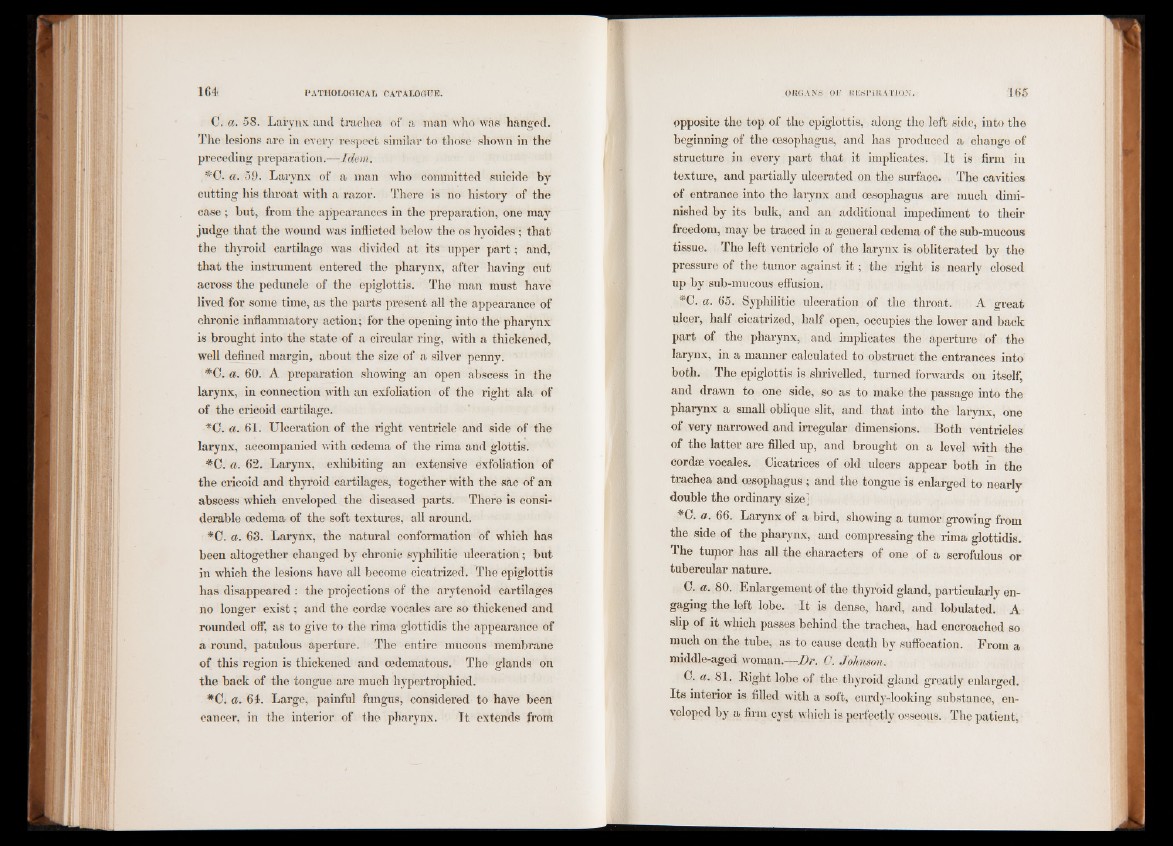
C. a. 58. Larynx and trachea of a man who was hanged.
The lesions are in every respect similar to those shown in the
preceding preparation.—Idem.
*‘C. a. 59. Larynx of a man who committed suicide by
cutting his throat with a razor. There is no history of the
case ; but, from the appearances in the preparation, one may
judge that the wound was inflicted below the os hyoides; that
the thyroid cartilage was divided at its upper part; and,
that the instrument entered the pharynx, after having cut
across the peduncle of the epiglottis. The man must have
lived for some time, as the parts present all the appearance of
chronic inflammatory action; for the opening into the pharynx
is brought into the state of a circular ring, with a thickened,
well defined margin, about the size of a silver penny.
#C. a. 60. A preparation showing an open abscess in the
larynx, in connection with an exfoliation of the right ala of
of the cricoid cartilage.
*0. a. 61. Ulceration of the right ventricle and side of the
larynx, accompanied with oedema of the rima and glottis.
*C. a. 62. Larynx, exhibiting an extensive exfoliation of
the cricoid and thyroid cartilages, together with the sac of an
abscess which enveloped the diseased parts. There is considerable
oedema of the soft textures, all around.
*0. a. 63. Larynx, the natural conformation of which has
been altogether changed by chronic syphilitic ulceration; but
in which the lesions have all become cicatrized. The epiglottis
has disappeared : the projections of the arytenoid cartilages
no longer exist; and the cordse vocales are so thickened and
rounded off, as to give to the rima glottidis the appearance of
a round, patulous aperture. The entire mucous membrane
of this region is thickened and cedematous. The glands on
the back of the tongue are much hypertrophied.
*C. a. 64. Large, painful fungus, considered to have been
cancer, in the interior of the pharynx. It extends from
opposite the top of the epiglottis, along the left side, into the
beginning of the oesophagus, and has produced a change of
structure in every part that it implicates. It is firm in
texture, and partially ulcerated on the surface. The cavities
of entrance into the larynx and oesophagus are much diminished
by its bulk, and an additional impediment to their
freedom, may be traced in a general oedema of the sub-mucous
tissue. The left ventricle of the larynx is obliterated by the
pressure of the tumor against it ; the right is nearly closed
up by sub-mucous effusion.
*C. a. 65. Syphilitic ulceration of the throat. A great
ulcer, half cicatrized, half open, occupies the lowTer and back
part of the pharynx, and implicates the aperture of the
larynx, in a manner calculated to obstruct the entrances into
both. The epiglottis is shrivelled, turned forwards on itself,
and drawn to one side, so as to make the passage into the
pharynx a small oblique slit, and that into the larynx, one
of very narrowed and irregular dimensions. Both ventricles
of the latter are filled up, and brought on a level with the
cordse vocales. Cicatrices of old ulcers appear both in the
trachea and oesophagus ; and the tongue is enlarged to nearly
double the ordinary size]
*C. o. 66. Larynx of a bird, showing a tumor growing from
the side of the pharynx, and compressing the rima glottidis.
The tuipor has all the characters of one of a scrofulous or
tubercular nature.
C. a. 80. Enlargement of the thyroid gland, particularly en-
gaging the left lobe. It is dense, hard, and lobulated. A
slip of it which passes behind the trachea, had encroached so
much on the tube, as to cause death by suffocation. From a
middle-aged woman.—Dr. C. Johnson.
C. a. 81. Right lobe of the thyroid gland greatly enlarged.
Its interior is filled with a soft, curdy-looking substance, enveloped
by a firm cyst which is perfectly osseous. The patient,